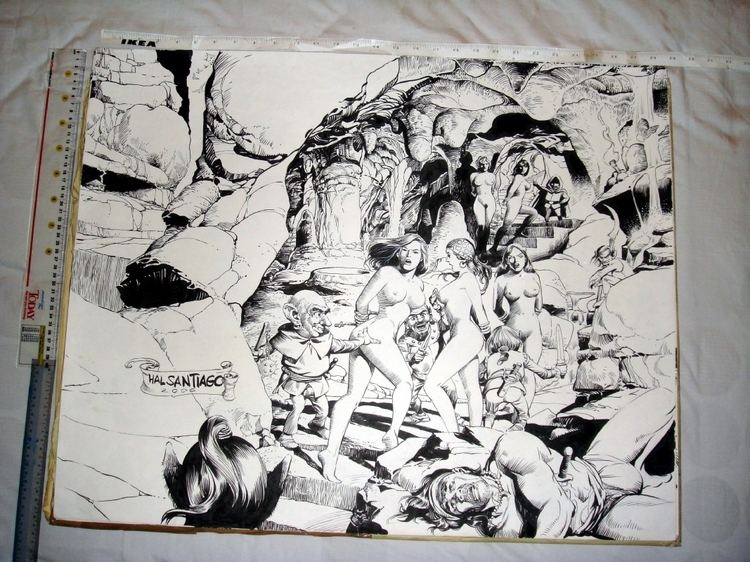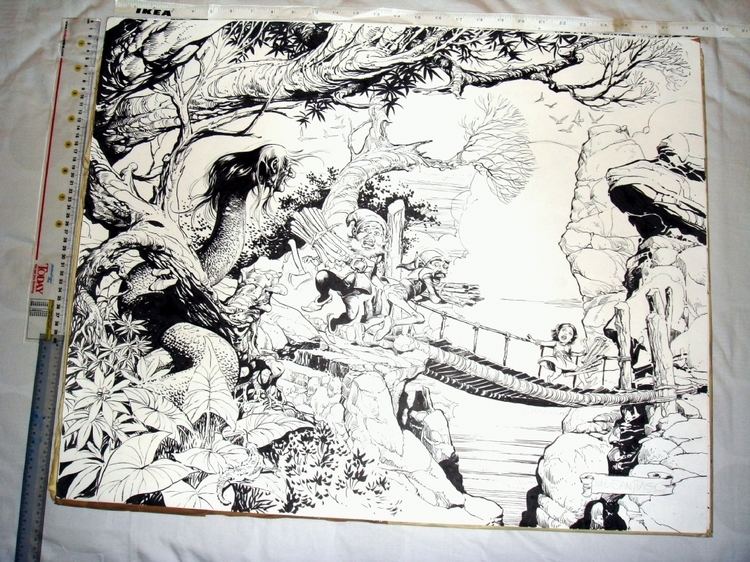Name Hal Santiago | ||
 | ||
Ikp mobile hal santiago on pinoy komiks
Dominador "Hal" Santiago is an award-winning Filipino illustrator and writer in the field of Philippine comics (known locally as komiks). He is the Philippines' Greatest Comic Illustrator and recognized in the comic book profession in the Philippines for his “artistic visualizations of various novels”. Santiago was described by Filipino writer Jim M. Fernandez as the “Raphael (Raffaello Sanzio, the Italian painter) of [Philippine comic book] Illustrators”. His illustrations for eight comics series makes him one of the most prolific Filipino comics illustrators, second only to Mar T. Santana, who has illustrated 17 series.
Contents

Philippines
Santiago began his career as an illustrator for the comics industry in the Philippines in 1958. He was a short-story illustrator for Manila Klasiks. He was later commissioned by Gil Evangelista of Screen Komiks to illustrate the novel Puso sa Puso (Heart to Heart) written by Bert Tablan. In the 1960s he illustrated for PSG Publishing House (also known as PSG Publications), where he drew the artwork for Tatlong Hari (Three Kings), a novel written by Rene Rosales and published in the pages of United Komiks.
He then became an “A-class” illustrator for Atlas Publications. Santiago illustrated the characters for Shanghai Joe, a novel authored by Danilo Roman. In the 1970s, Santiago created the Philippine comics novels Pinoy Houdini (Filipino Houdini), Talim (i.e. sharpness [of the edge of a blade, knife, or sword]), and The Hands while working for Graphic Arts Service, Inc. (GASI). Among the other novels Santiago illustrated for GASI were: Sun God, written by Pablo S. Gomez, Saka Natin Itanong sa Diyos (We'll Ask God Later), written by Carlo J. Caparas, Isang Minutong Kasalanan (One-Minute Long Sin), written by Elena M. Patron, and Medusa and Unica (Spanish word for "unique"), both authored by Jim M. Fernandez.
Santiago wrote and illustrated his own novel, Huling Umaga (Final Morning), while working for Atlas Publications. In collaboration with Federico C. Javinal, he produced the Men of Iron in Monsters of the Universe. Santiago then went on to create other novels such as Zarbot for Aliwan Komiks, Japanese Bat, and Anak ni Zuma (Child of Zuma). Santiago was also the illustrator for Ricardo M. Luna's Mga Bakal at Kalawang (Steel and Rust), a novel featured in Liwayway magazine.
United States
During the 1970s, Santiago went to the United States to work for Marvel and other American-based comic book companies.
Influences
The young Santiago was influenced by Harold "Hal" Rudolf Foster, a comic book artist from the United States who illustrated the Tarzan (1929) and Prince Valiant characters. Foster was the creator of Prince Valiant. Because he idolized Foster, Santiago exchanged letters with Foster in 1958 in order to learn the ropes of comic book illustration. Santiago changed his given name and adopted the name "Hal" after the name Foster used in the comic book industry.
Awards
In 1980, Santiago received the Best Illustrator Award from WIKA, an association of Philippine comics distributors. In 1984, WIKA awarded Santiago the Best Written and Illustrated Novel by an Artist Award for his The Hands.
Works
According to John A. Lent in his book Pulp demons: international dimensions of the postwar anti-comics campaign, Santiago's novel The Hands is regarded as "one of the most success fantasy stories in Philippine comics". A serial that began in 1980, the plot of The Hands is about 'a pair of super-strong, telekinetic, "chopped-off, one eyed living hands.'" On the other hand, Santiago's The Gorgon – a serial Santiago created together with Jim Fernandez – is about a character with a "snake-infested hairdo".
The following is an enumeration of Santiago’s published works arranged according to the title of the novel, followed by the comic book where it appeared, and the year(s) of publication:
